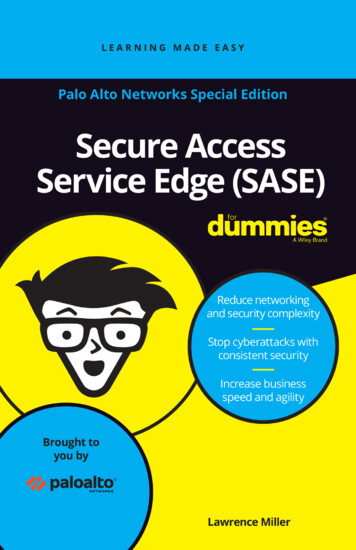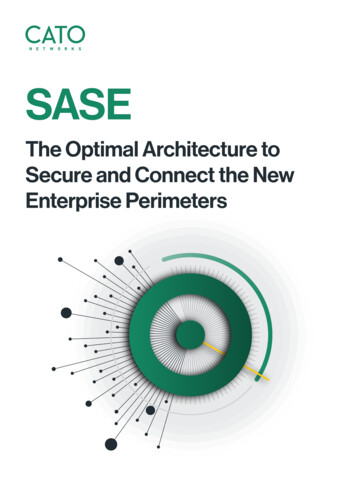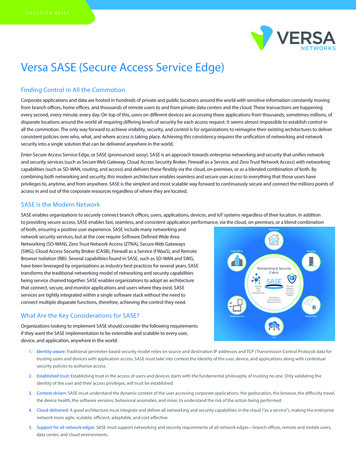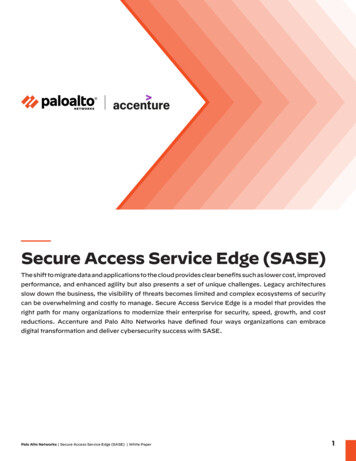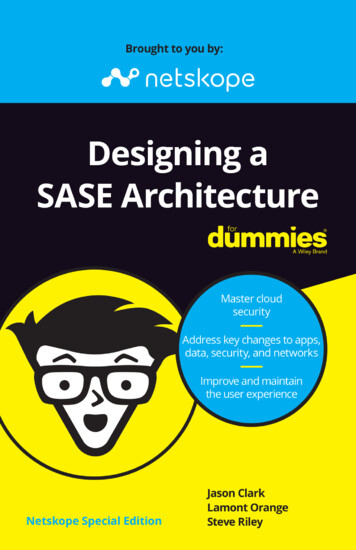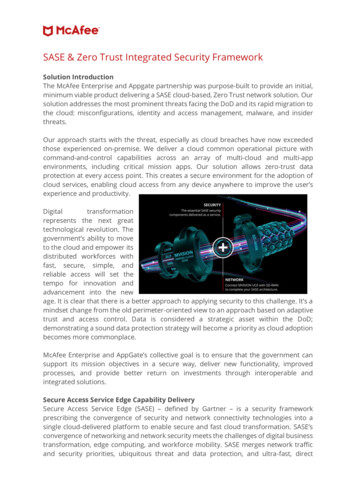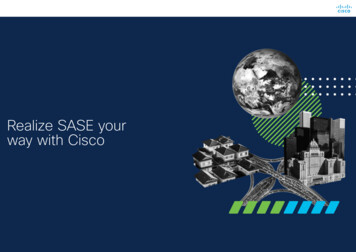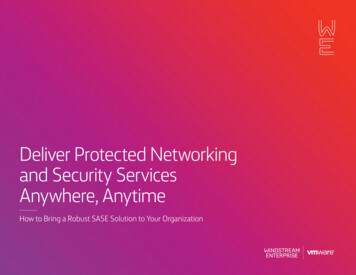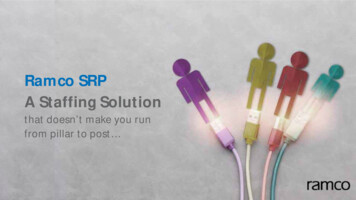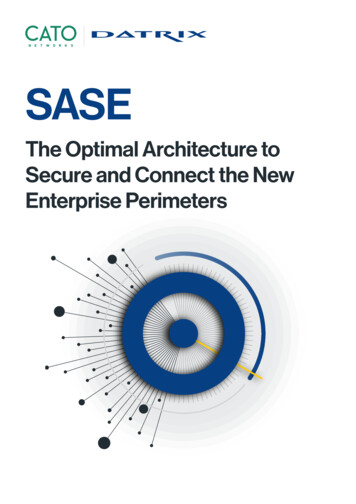
Transcription
SASEThe Optimal Architecture toSecure and Connect the NewEnterprise Perimeters
IntroductionThe enterprise Perimeter has been the focus of networking and securityleaders for decades. The basic planning assumption, and associatedbest practices, was that the Perimeter was drawn around the corporatedatacentre that hosted all sensitive data and applications. IT has investedsignificant resources to secure all traffic coming into and going out ofthe Perimeter with network security technologies like firewalls, intrusionprevention systems, secure web gateways, and more.Beyond security, the Perimeter was a clear physical boundary that requiresoptimal connectivity to the outside world: employees, partners, suppliers,and later distributed applications across regions and the cloud.The single enterprise Perimeter paradigm came under pressure over thepast decade. The datacentre Perimeter was stretched with the migrationof many applications to cloud datacentres and public cloud services. Thecombination of cloud applications and the expanding mobile workforcecreated new traffic patterns that completely bypassed the traditionaldatacentre Perimeter.This change in the way modern enterprises conduct business, and usecloud and mobile technology, requires a new architecture that is notbased on a single Perimeter design. This architecture, the Secure AccessService Edge (SASE), was defined by Gartner, as a way to secure thenew enterprise multi-Perimeters. In this document, we will explore SASEand how it can address a range of common use cases with optimal userexperience and without compromising security.N e t w o r k a t t h e S p e e e d o f N OWTelcos and the Future of the WAN in 20192
What is SASE and How itEffortlessly Secures AllEnterprise PerimetersThe Secure Access Service Edge (SASE) is a new enterprise networking technology categoryintroduced by Gartner in 2019. SASE converges the functions of network and security point solutionsinto a unified, global cloud service. These include SD-WAN, Global Private Backbone, Secure WebGateway, Firewall as a Service, and more. SASE architecture is marked by four main attributes. It isidentity-driven, cloud-native, supports all edges, and is distributed globally.SASE Architectural AttributesIdentity-drivenUser and resource identity, not simply an IP address, drives SASE networkingand security policies. This approach reduces operational overhead by lettingcompanies develop one set of networking and security policies for usersregardless of device or location.Cloud-nativeSASE is a cloud-first and cloud-native architecture. All networking andsecurity functions are implemented in the cloud. Only capabilities that must bedeployed at the edge, are delivered as simple edge clients. SASE architectureleverages key cloud capabilities including elasticity, adaptability, self-healing,and self-maintenance to uniformly deliver security and networking capabilitiesacross the enterprise.N e t w o r k a t t h e S p e e e d o f N OWTelcos and the Future of the WAN in 20193
Supports All EdgesSASE creates one secure network for all company entities — datacentres,branch offices, cloud resources, and mobile users. For example, SD-WANappliances support physical edges while mobile clients and clientless browseraccess connect users on the go, and while working from home.Globally DistributedTo ensure the full networking and security capabilities are availableeverywhere and deliver the best possible experience to all edges, the SASEcloud is globally distributed across dozens of Point of Presence (PoPs).Enterprise edges connect to the nearest PoP so all traffic is secured andoptimised at the PoP and across the global backbone of PoPs to its destination.N e t w o r k a t t h e S p e e e d o f N OWTelcos and the Future of the WAN in 20194
SASE is Optimisedfor Total Visibilityand ControlSASE’s cloud-first architecture is uniquely positioned to support the change to the enterprisePerimeters. How? The primary problem presented by the changes to the Perimeters is restrictedtraffic visibility and inspection blind spots. Traditional appliance-based security is optimised tosecure a single traffic path. To ensure visibility and control of all traffic paths such as mobile-to-cloudor branch-to-cloud, enterprises had to force all traffic through their datacentre Perimeter – or gowithout security at all. This is a sub-optimal design that adds latency and pressures the datacentresecurity engines.SASE architecture is built for full visibility to all traffic from all edges - physical, cloud, and mobile including traffic between the edges (WAN), and from the edges to the Internet. SASE applies a rich setsecurity and networking engines on that traffic, for full inspection for threat prevention and accesscontrol. This is why SASE has been touted, by Gartner, as the future of networking and security.SASE CLOUDConverged Traffic Optimisation, Access Control, Threat PreventionWWWSASE Cloud EdgeSASE PoPIntneretkGlobal Private BacInternetSASE SD-WAN EdgeMPLSBranchboneIPSecSASE Device EdgeDatacentreSASE Management ApplicationMobileN e t w o r k a t t h e S p e e e d o f N OWTelcos and the Future of the WAN in 20195
SASE ComponentsSASE CloudSASE EdgeA globally distributed cloud service thatDesigned to connect a specific edge to thedelivers the networking and securitySASE cloud. SASE clients include SD-WANcapabilities to all edges. The SASE cloudappliances for branches, IPSec-enabledoperates as a single entity and its internalfirewalls and routers, and device agents forstructure is transparent to the end users.Windows, Mac, iOS, Android, and Linux.SASE PoPSASE ManagementA specific instance within the SASE CloudA cloud-based management application tothat hosts the resources needed to deliverconfigure all policies and view network andthe SASE capabilities including servers,security analytics and real-time status.network connectivity, and software. SASEPoPs are symmetrical, interchangeable,multi-tenant, and mostly stateless. They arebuilt to serve any enterprise edge connectedthrough them as an integral part of thatparticular enterprise network.The enterprise new Perimeter is, in fact, multiple Perimeters each representing a new line of sight,between users and applications. Enterprises think about these new Perimeters as separate gaps, thatforce the deployment of new network and security solutions for branches, users, and clouds. Thispiecemeal approach leads to immense complexity, inferior service, and weak security. A true SASEplatform, built on a cloud-first architecture, has full visibility and control of all enterprise traffic. Bydesign, SASE eliminates enterprise blind spots which makes it the ideal platform to optimally connectand secure the modern enterprise.N e t w o r k a t t h e S p e e e d o f N OWTelcos and the Future of the WAN in 20196
SASE Connects andSecure the ModernEnterpriseLet’s take ACME Corp and its evolving enterprise infrastructure. From a rigid and static networkdesign of branch-to-datacentre connectivity, ACME is in the midst of deploying its applications innew physical and cloud datacentres (IaaS) and migrating others to the public cloud (SaaS). Accessrequirements have evolved too. Users no longer need to access all applications from the branchesand offices, but also need to connect from home and while on the road.MPLSFirewallwwwDatacenterVPNBranchMobile userACME Legacy NetworkN e t w o r k a t t h e S p e e e d o f N OWTelcos and the Future of the WAN in 20197
Use Cases1Securely Connect ACME Branchesto Any ApplicationBeforeSASETrombone Effect and a Security ChokepointACME needs to securely and optimally connect its branches to the applications– wherever they are. Branches are connected to the datacentre and from there tothe cloud. This creates two problems. First, is the added latency, also known as the“Trombone Effect” of sending the traffic for inspection to a different physical location.Second, is the increased load on the datacentre firewalls as a result of the increaseuse of the cloud to host distributed applications.WithSASEOptimal and Secure Branch to Application AccessACME plugs all its branches into the SASE Cloud using edge SD-WAN appliances,and specifically to the SASE PoP nearest to each location All branch traffic, bothWAN and Internet, is fully inspected at the SASE PoP, and then routed optimally tothe target application via the nearest PoP to its location (on premises, in a cloud DC,or the public cloud). There is no “Trombone Effect”, and there is no single securitychokepoint.SASE CLOUDConverged Traffic Optimisation, Access Control, Threat PreventionWWWSASE PoPHybrid/Multi CloudkboneGlobal Private BacIPSecBranchDatacenterDatacentreN e t w o r k a t t h e S p e e e d o f N OWTelcos and the Future of the WAN in 2019SASE Management Application8
2Securely Connect ACME RemoteUsers to Any ApplicationBeforeSASETrombone Effect and a Security ChokepointACME wants to securely and optimally connect its remote users to the applicationsthey need – wherever they are. Users currently use VPN clients to connect to thefirewall in the datacentre, and from there to get to their applications. This createdthree problems. First, the use of the public Internet for VPN access created a baduser experience for global access from the user location to the datacentre Perimeter.Second, users where able to access public cloud applications directly, without anysecurity enforcement or threat prevention applied. Third, in such case when theentire company had to work remotely, the current VPN infrastructure was unable tomeet the sudden increase in traffic volume.WithSASEOptimal and Secure User to Application AccessAll ACME remote users connect to the nearest SASE PoP using SASE device clientsor browser-based based clientless access. All user traffic, both WAN and Internet, isfully inspected at the PoP, and then routed optimally to the target application via thenearest SASE PoP to its location (on premises, in a cloud DC, or the public cloud).SASE addresses the three challenges described above. SASE global backboneoptimises the traffic from the user location to the target application and delivers abetter user experience versus the public Internet. All traffic is inspected at the PoPincluding WAN, Internet, and Cloud-bound traffic – so consistent security policy isenforced. And remote users’ traffic is automatically load balanced within and acrossSASE PoPs to ensure unlimited scalability and the elimination of single point of failureand performance bottlenecks.SASE CLOUDConverged Traffic Optimisation, Access Control, Threat PreventionWWWSASE PoPneuneTvicboneDekGlobal Private BaclWFH UserIPSecDatacenterDatacentreSASE Device EdgeMobileN e t w o r k a t t h e S p e e e d o f N OWTelcos and the Future of the WAN in 2019SASE Management Application9
3BeforeSASEOptimally Connect ACME BranchesGlobally to a New Cloud ERP SystemStatic Global MPLS network into a PhysicalDatacentreACME’s core business application is hosted in its datacentre in Germany. The entireMPLS network was built to optimise access to that datacentre globally. This wasa hard-wired design. ACME decision to migrate its ERP to a cloud datacentre, toimprove up time and simplify disaster recovery planning, had required a rethinkingof the network. ACME didn’t want to continue routing all traffic to its datacentre overMPLS and then send the traffic to the cloud.WithSASEOptimised and Secure Global ERP Access for AllLocations and UsersWith SASE, ACME can eliminate the tight coupling of the network design andthe business requirements. Such design can’t respond to changes in businessrequirements (such as cloud migration for better availability and uptime) without amajor overhaul of the network or a sub-optimal service.ACME will plug its cloud datacentre to SASE on one-hand and all of its branchesand users on the other hand. The SASE core will optimally egress all traffic to thecloud ERP system at the Frankfurt PoP from all edges. All traffic will be subject to fullaccess control and deep packet inspection. This design will enable ACME to not onlyadapt to current requirements, but also to support future changes to the networksuch as migration between cloud providers, the distribution of the cloud ERP systemacross regions, and more.SASE CLOUDConverged Traffic Optimisation, Access Control, Threat PreventionSASE PoPIentrnetkGlobal Private BacIPSecBranchDatacenterDatacentreboneSASE Device EdgeMobileN e t w o r k a t t h e S p e e e d o f N OWSASE Management ApplicationTelcos and the Future of the WAN in 201910
4Securely Connect ACME Multi-Cloudand On-Premise Datacentres (Future)BeforeSASEComplex Networking and Security DeploymentACME is considering the use of multiple cloud providers in addition to its owndatacentres. ACME would need to deploy virtual firewalls at the edge of each cloudprovider and build a full mesh across its datacentres. Alternatively, it needs to use thenative routing and security mechanisms of each provider, which required specialisedand dedicated resources. To optimise access to each cloud provider, a premiumconnectivity service, like AWS Direct Connect and Azure ExpressRoute, wouldbe required.WithSASEOptimal and Secure Any-to-Any DC ConnectivityAll ACME cloud and physical datacentres plug into the nearest SASE CloudPoPs. Connectivity is established over IPSec tunnels or virtual edge SD-WANappliances. Cloud-to-Cloud and Cloud-to-Physical DC Traffic is inspected insidethe SASE PoP and the optimally routed across the SASE global backbone to thedestination. Because SASE treats each datacentre as an edge, all edges includingphysical, cloud, or mobile, benefit from traffic optimisation without the use ofpremium connectivity options. Better yet, the centralisation of the security policyand enforcement within the SASE Cloud, ensures a consistent and coherent policyapplies across all traffic independent of the underlying cloud provider native controls.SASE CLOUDConverged Traffic Optimisation, Access Control, Threat PreventionAgent/AgentlessSASE PoPHybrid/Multi CloudkboneGlobal Private BacIPSecDatacenterDatacentreN e t w o r k a t t h e S p e e e d o f N OWTelcos and the Future of the WAN in 201911
About Cato NetworksCato is the world’s first SASE platform, converging SD-WAN and network security into a global,cloud-native service. Cato optimises and secures application access for all users and locations.Using Cato, customers easily migrate from MPLS to SD-WAN, optimise global connectivity toon-premises and cloud applications, enable secure branch Internet access everywhere, andseamlessly integrate cloud datacentres and mobile users into the network with a zero trustarchitecture. Using Cato, customers easily migrate from MPLS to SD-WAN, optimise connectivityto on-premises and cloud applications, enable secure branch Internet access everywhere, andseamlessly integrate cloud datacentres and mobile users into the network with a zero-trustarchitecture. With Cato, the network, and your business, are ready for whatever’s next.SASE CLOUDConverged Traffic Optimisation, Access Control, Threat PreventionCloud OptimisationNG FirewallWAN OptimisationSecure Web GatewayGlobal Route OptimisationAdvanced Threat PreventionSelf-healing ArchitectureCloud and Mobile Global Private BacInternetEdge SD-WANAgent/AgentlessMPLSHybrid/Multi CloudboneIPSecClient/ClientlessSDPActive / Active / ActiveDynamic Path SelectionBranchApplication- and User Aware QoSDatacentreRemote UserPacket Loss MitigationN e t w o r k a t t h e S p e e e d o f N OWTelcos and the Future of the WAN in 201912
About DatrixEstablished over 25 years ago, digital transformation is the driving force behind the evolution ofDatrix services and solutions. Our professional and technical services teams adopt a consultative,client-centric approach that sees us design, build and manage superior solutions.Our critical networking, communications and cyber security solutions are the preferred choice forthe nation’s key institutions, as well as public and private sector organisations seeking to addressthe business challenges of compliance, performance, availability and affordability. 44 (0)20 7749 0800enquiries@datrix.co.uksales@datrix.co.ukLondon Head Office, Gray's Inn House127 Clerkenwell Road, London EC1R 5DB
major overhaul of the network or a sub-optimal service. ACME will plug its cloud datacentre to SASE on one-hand and all of its branches and users on the other hand. The SASE core will optimally egress all traffic to the cloud ERP system at the Frankfurt PoP from all edges. All traffic will be subject to full access control and deep packet .
